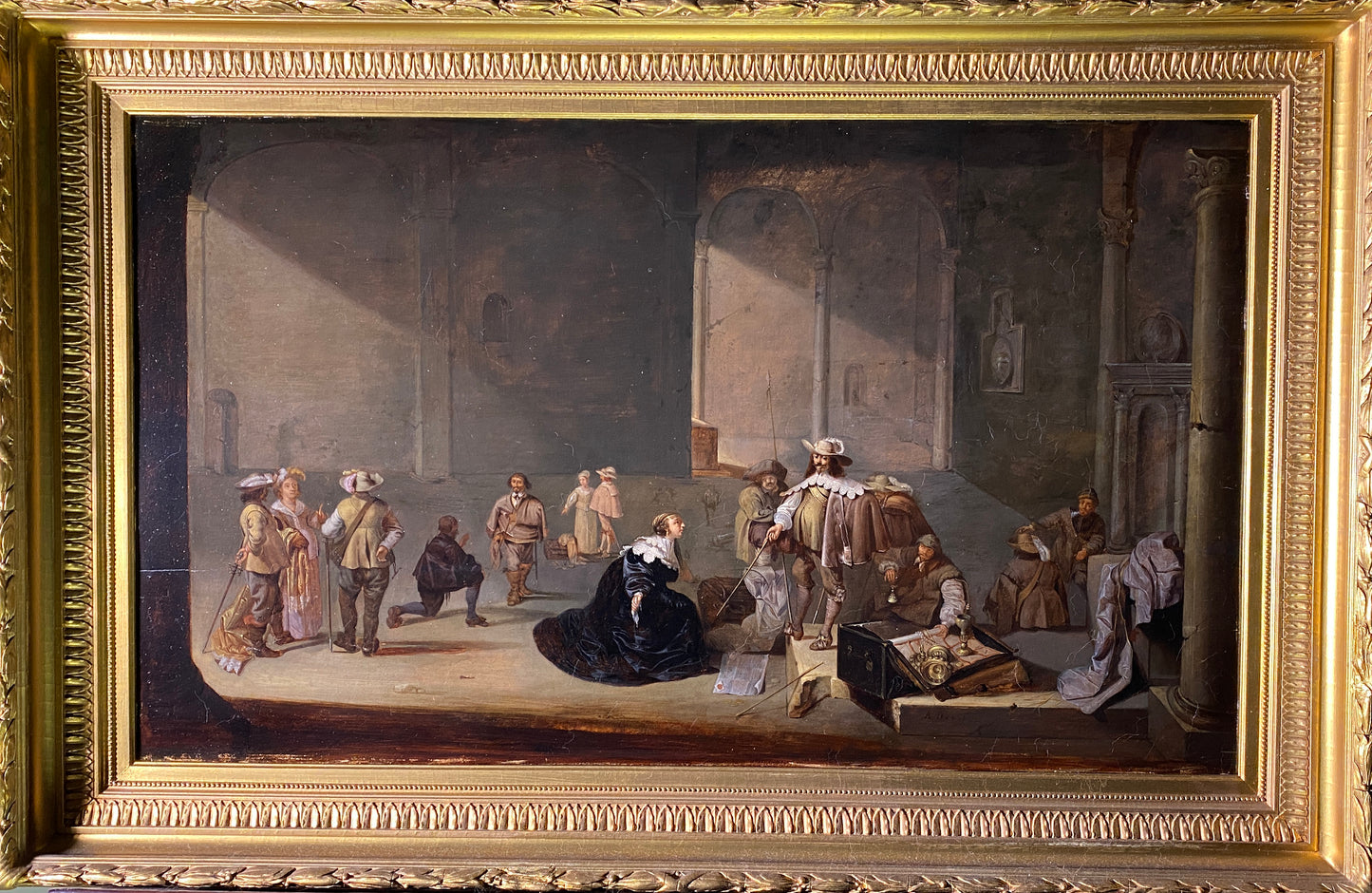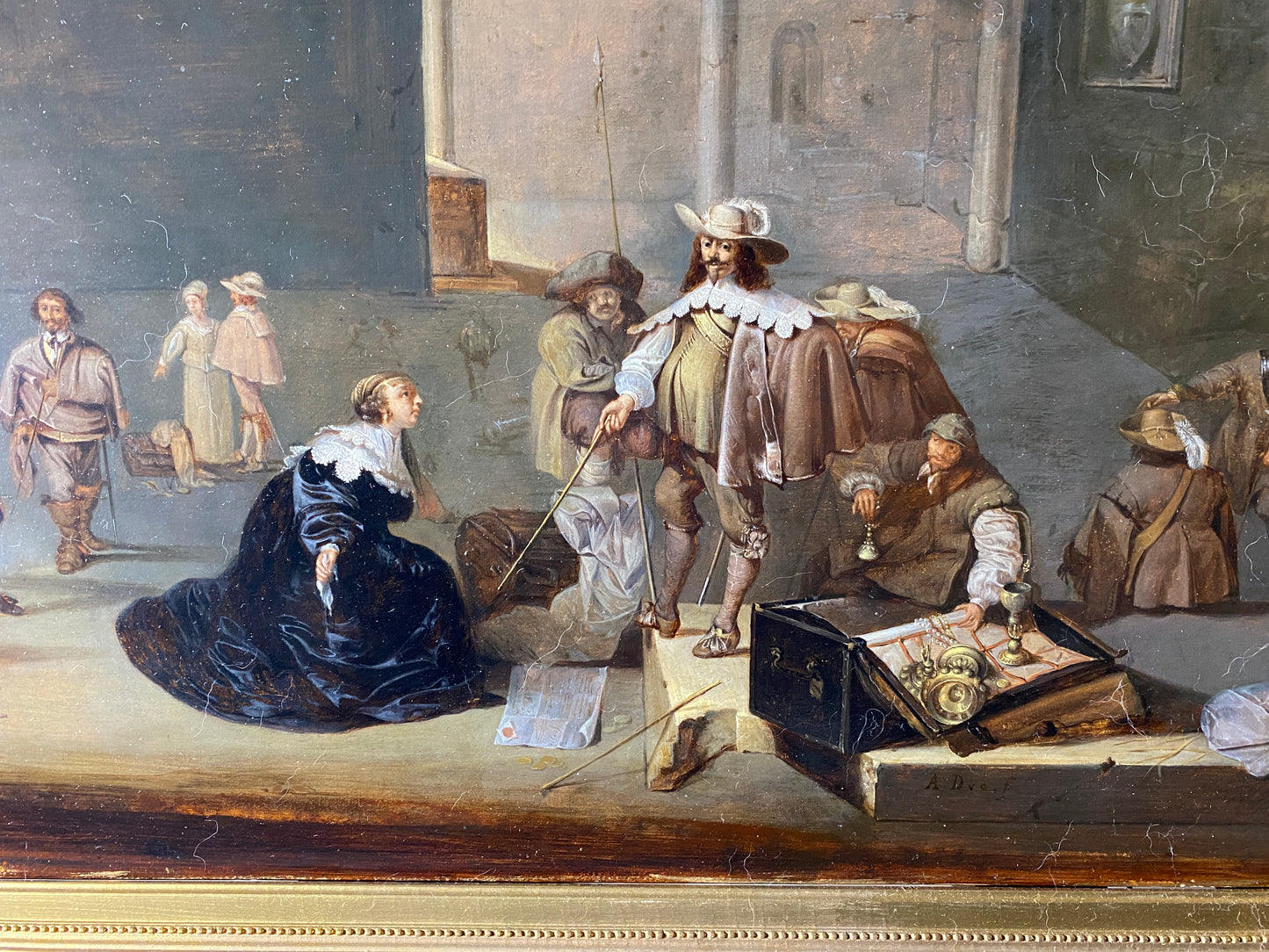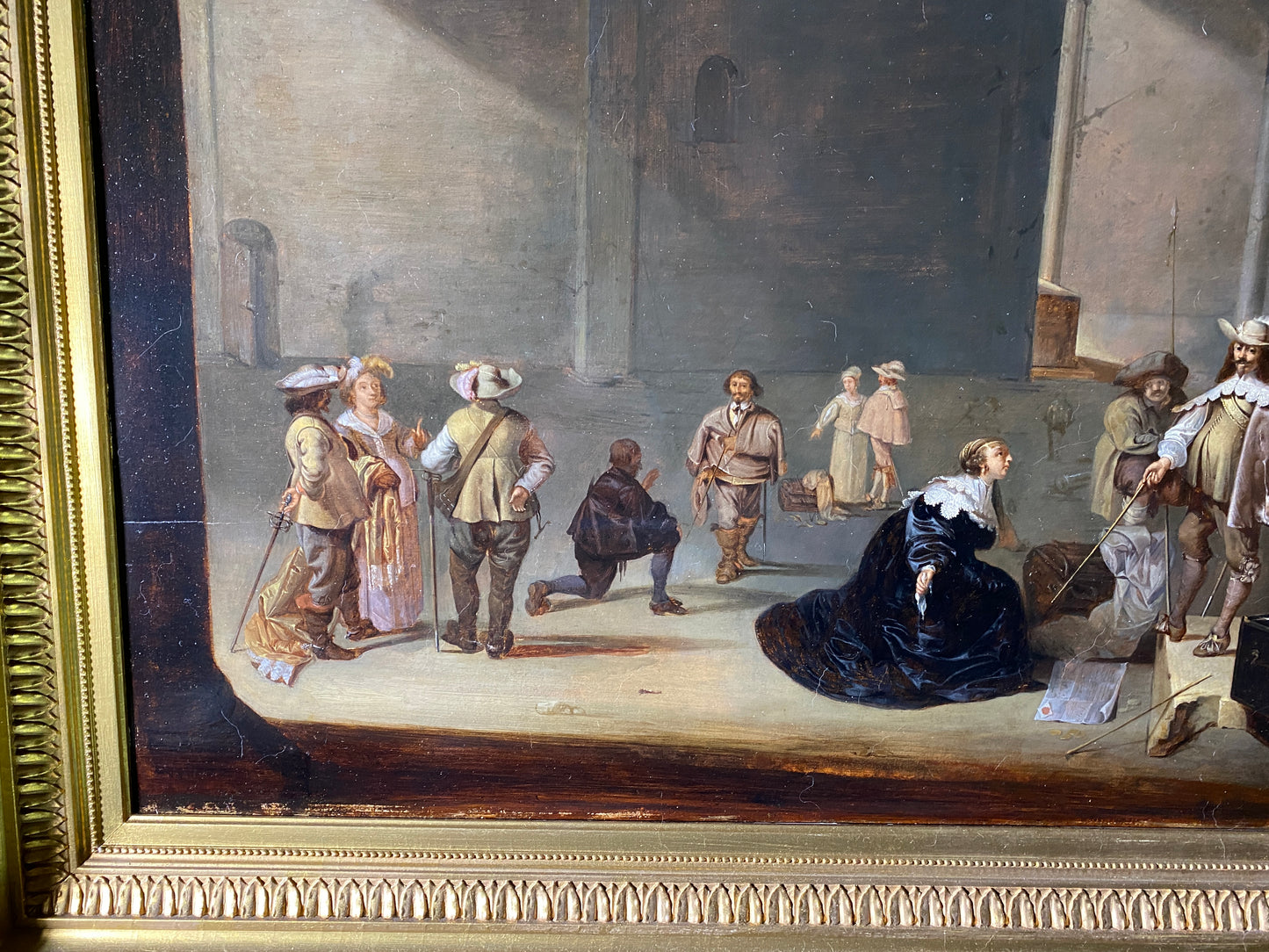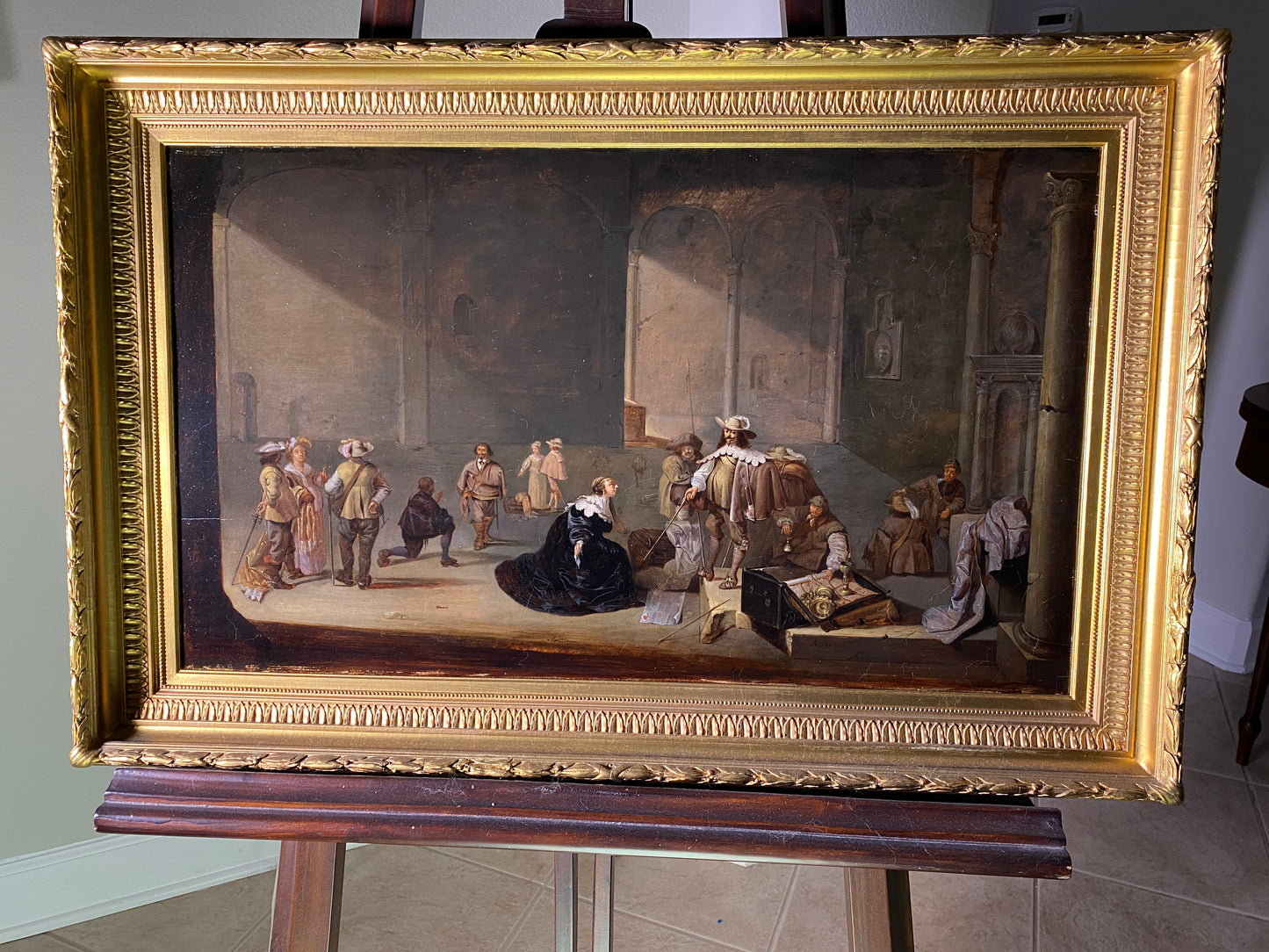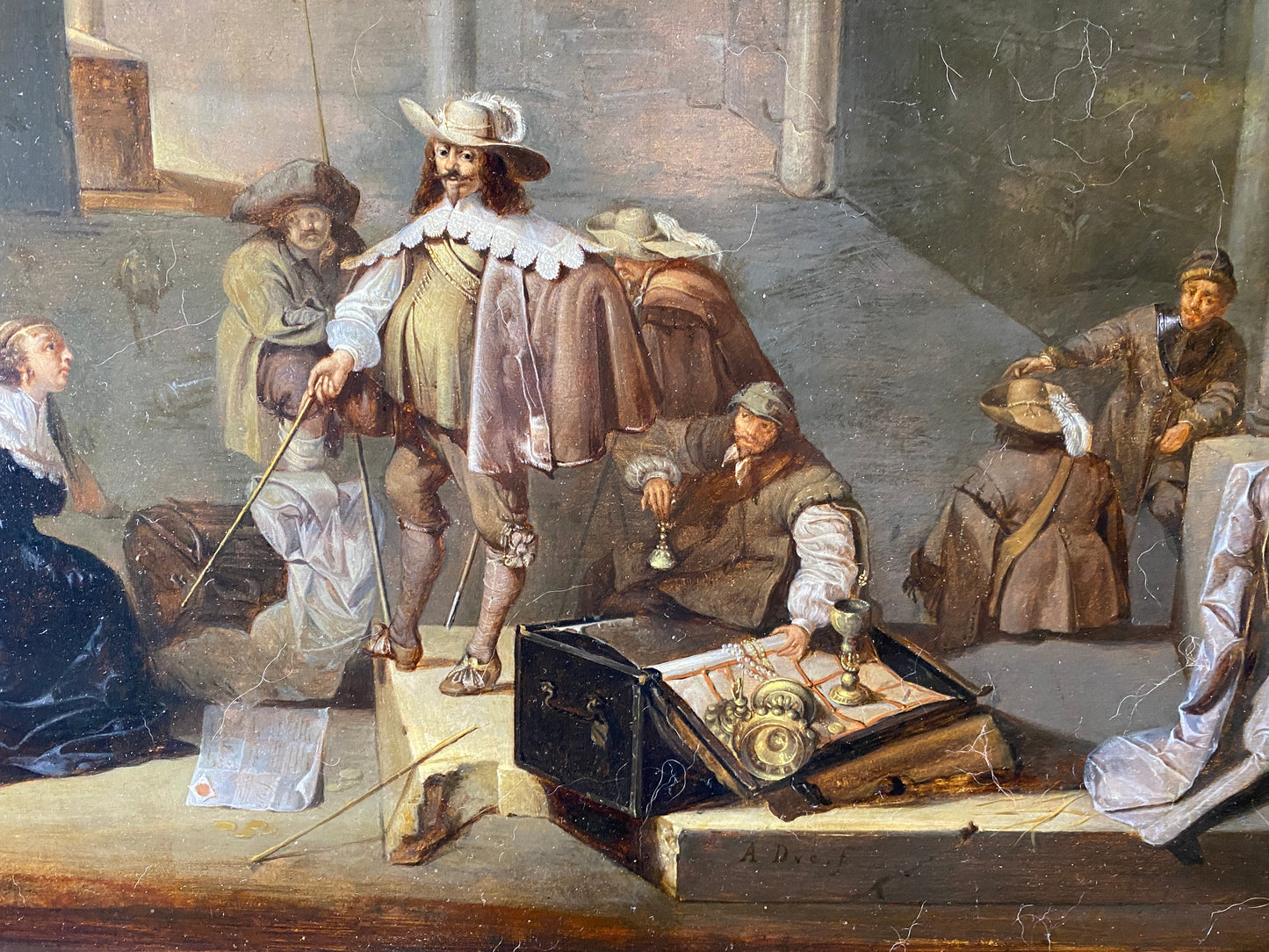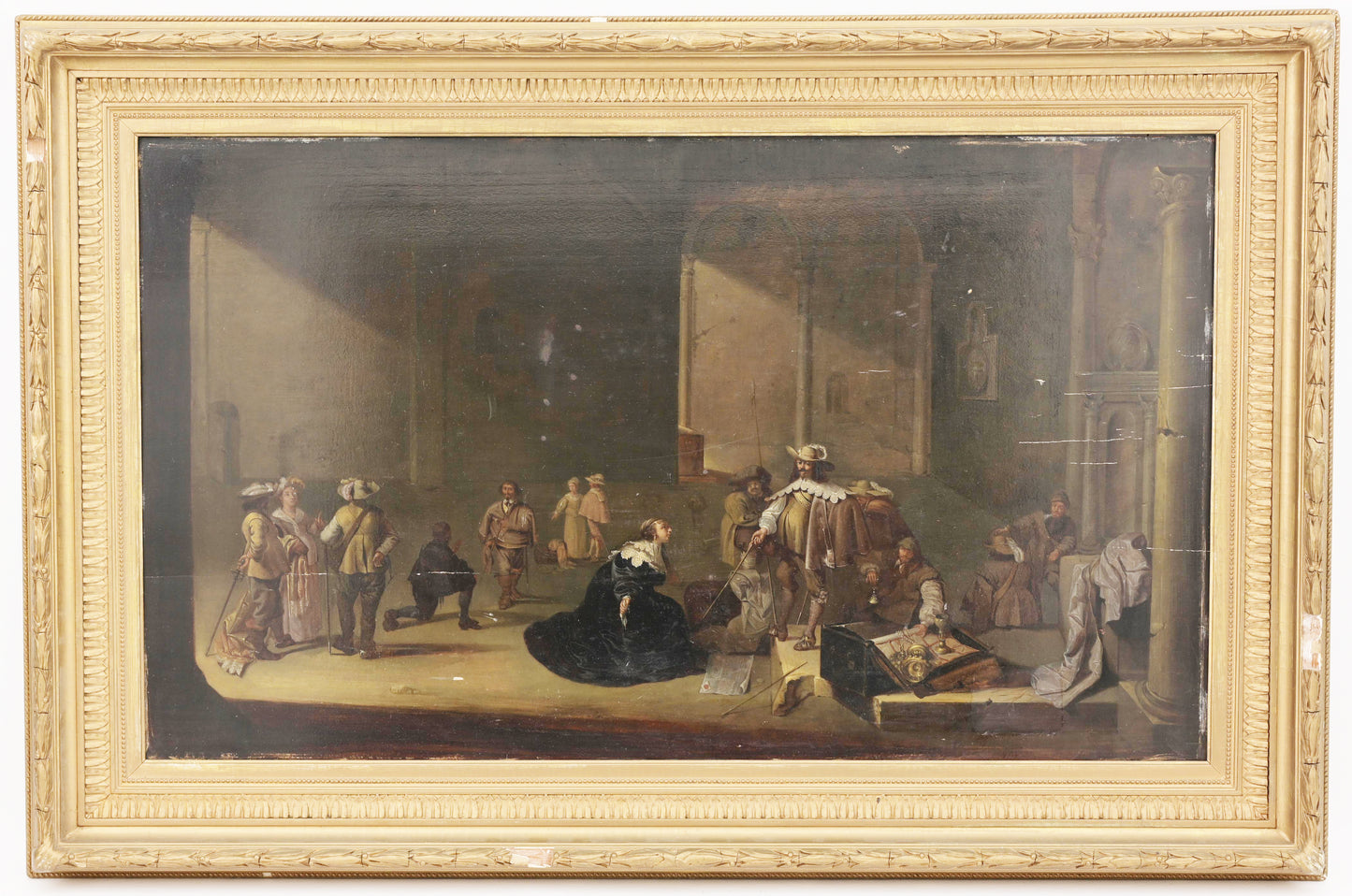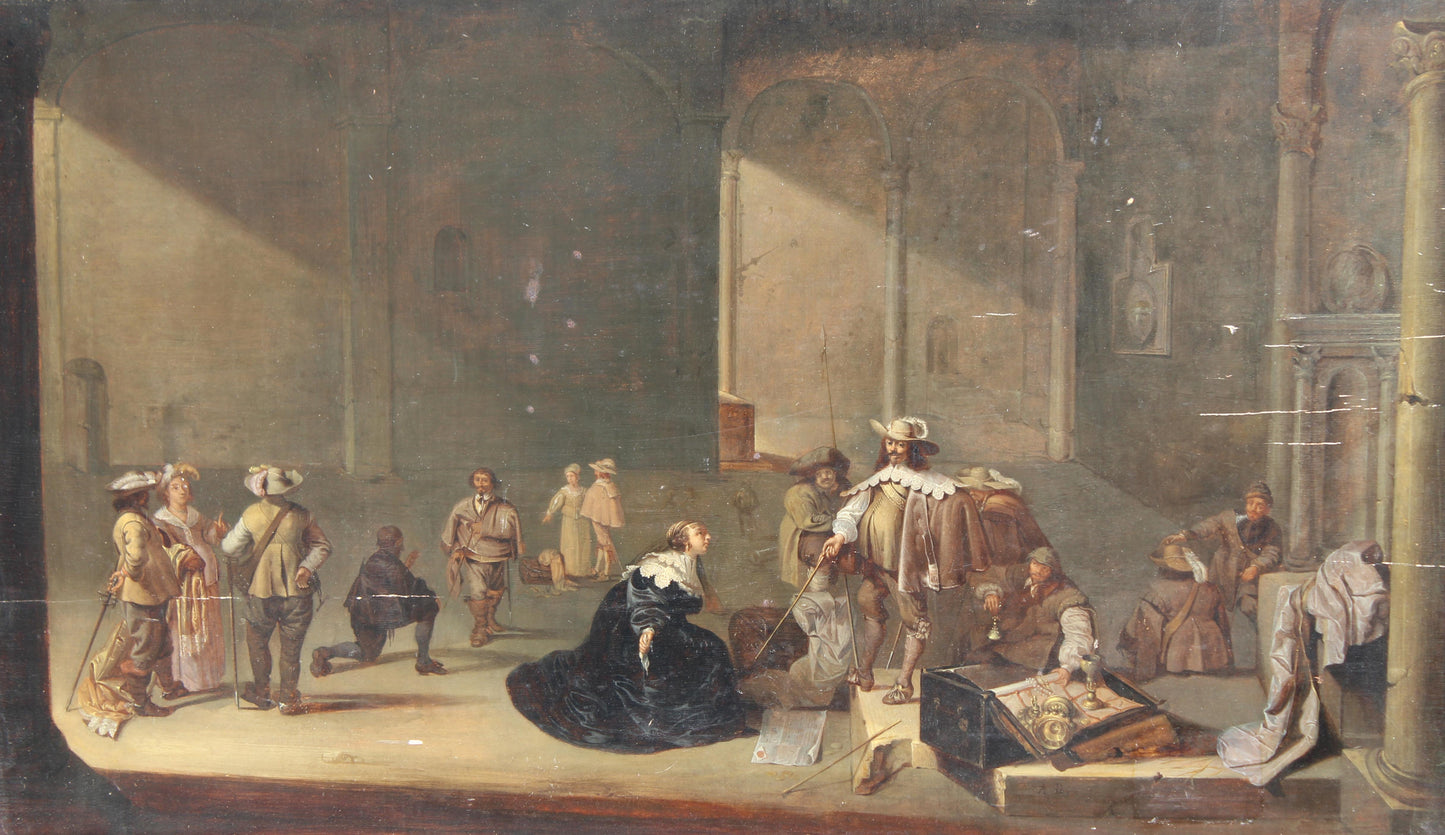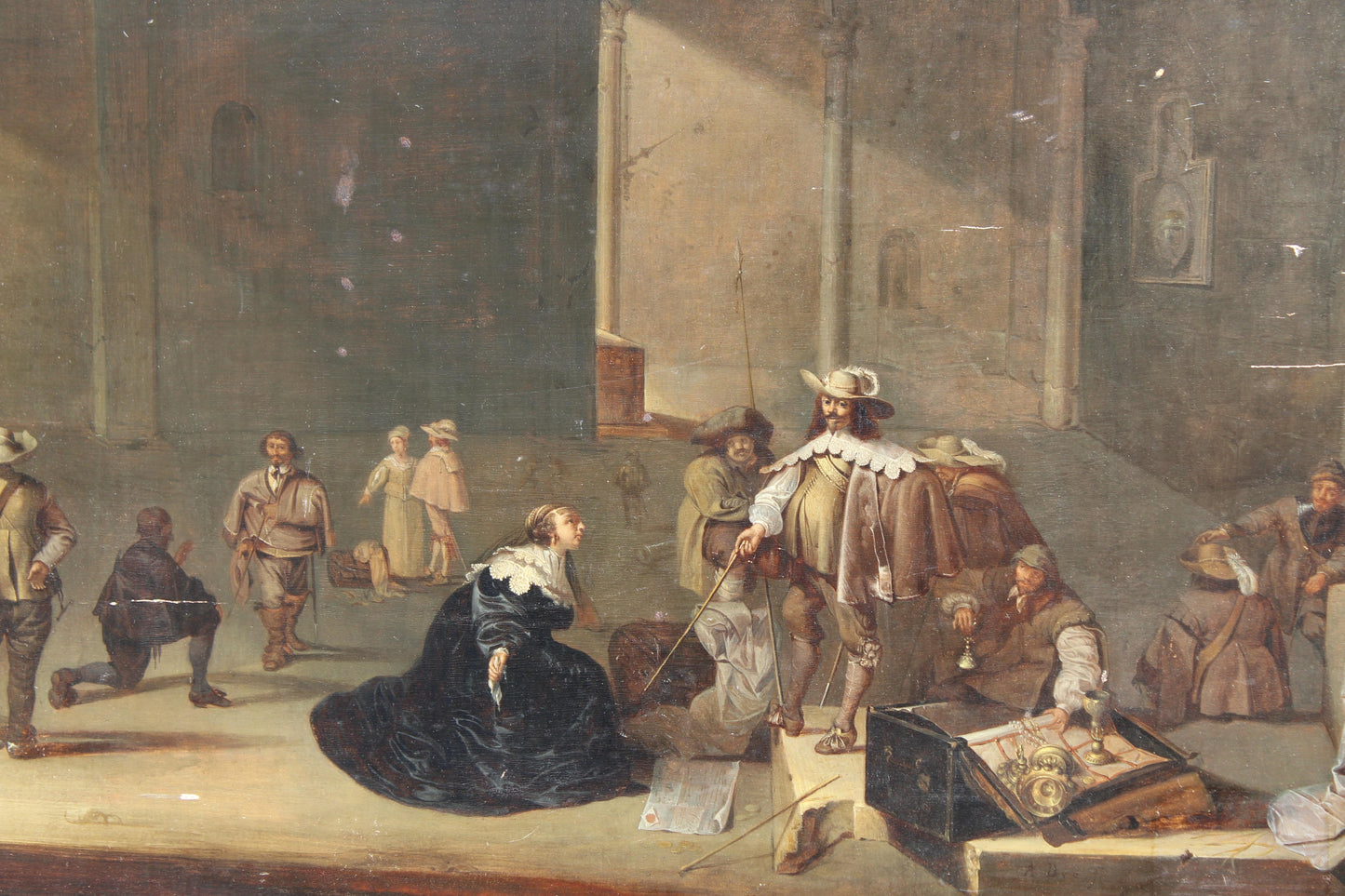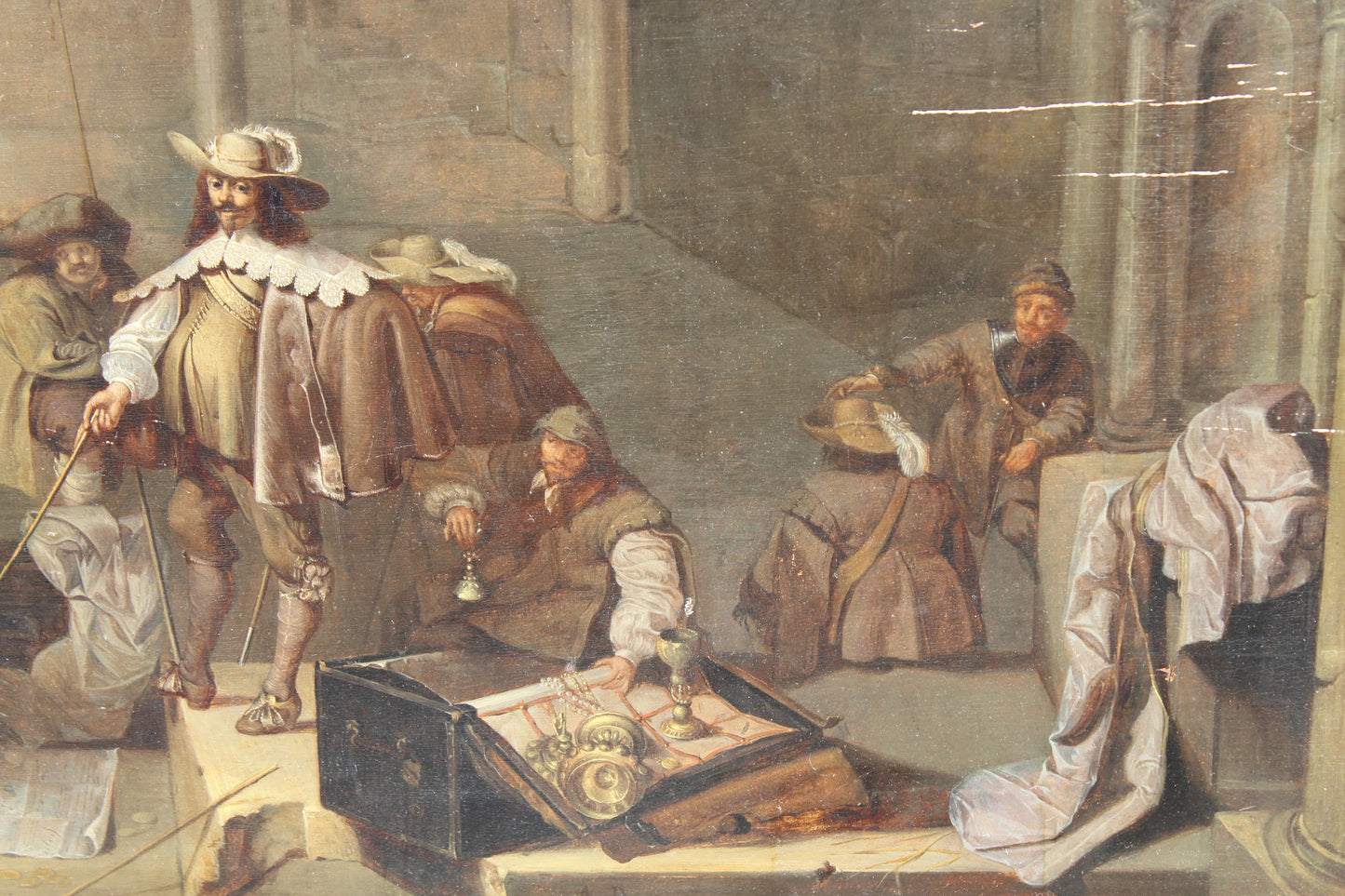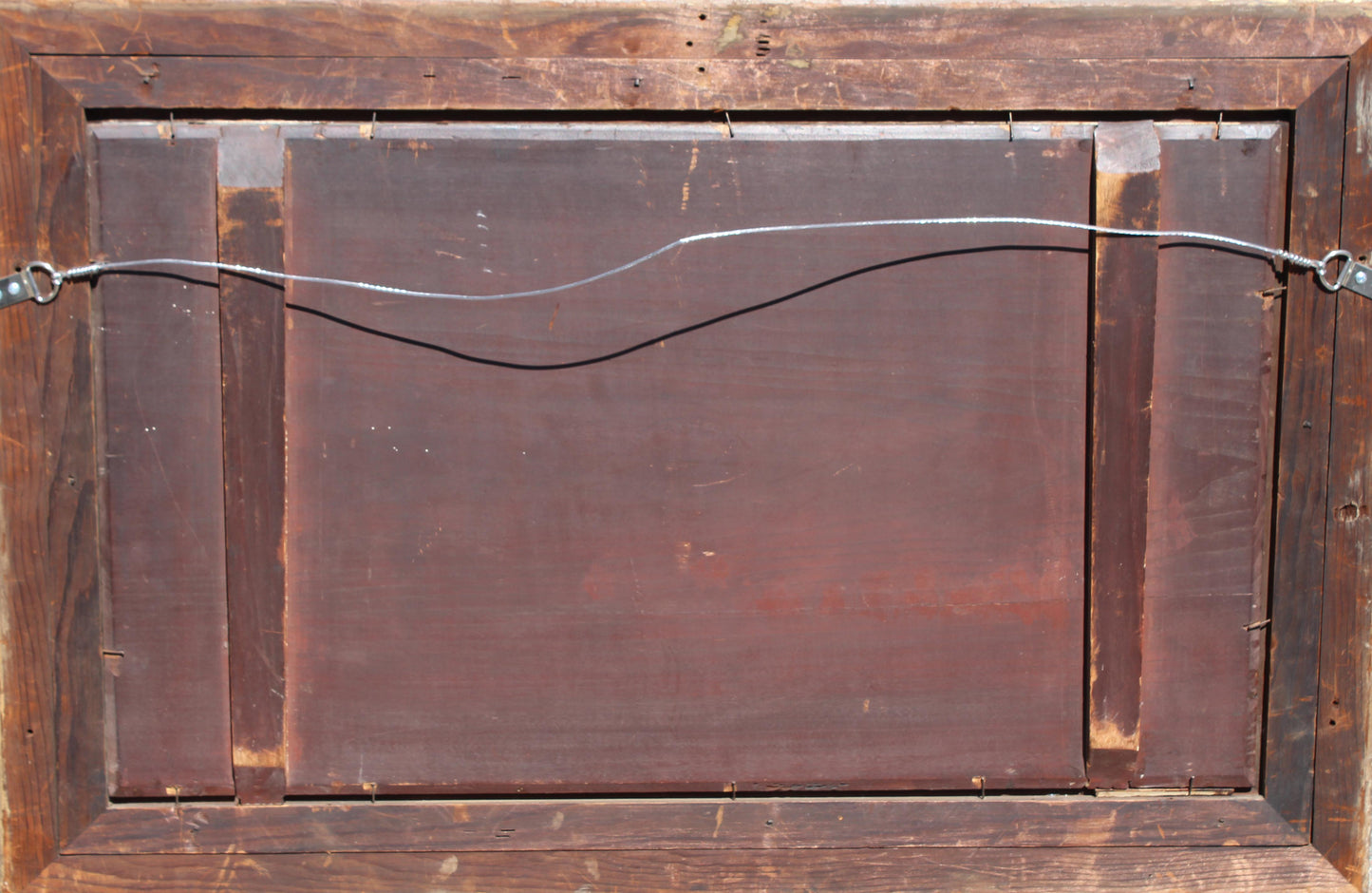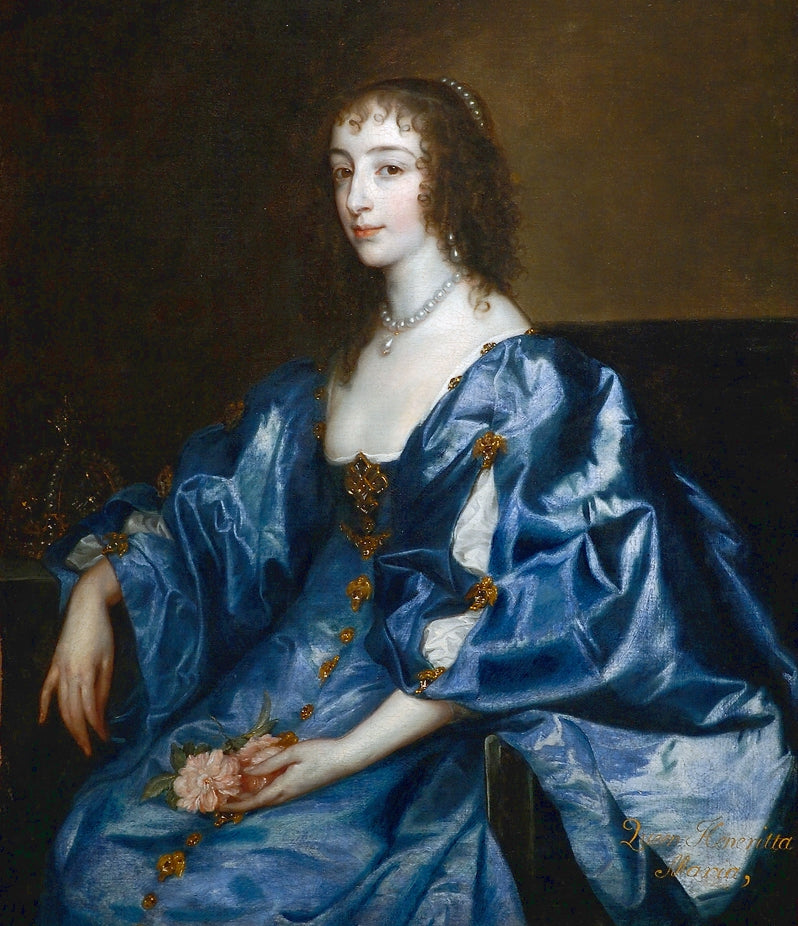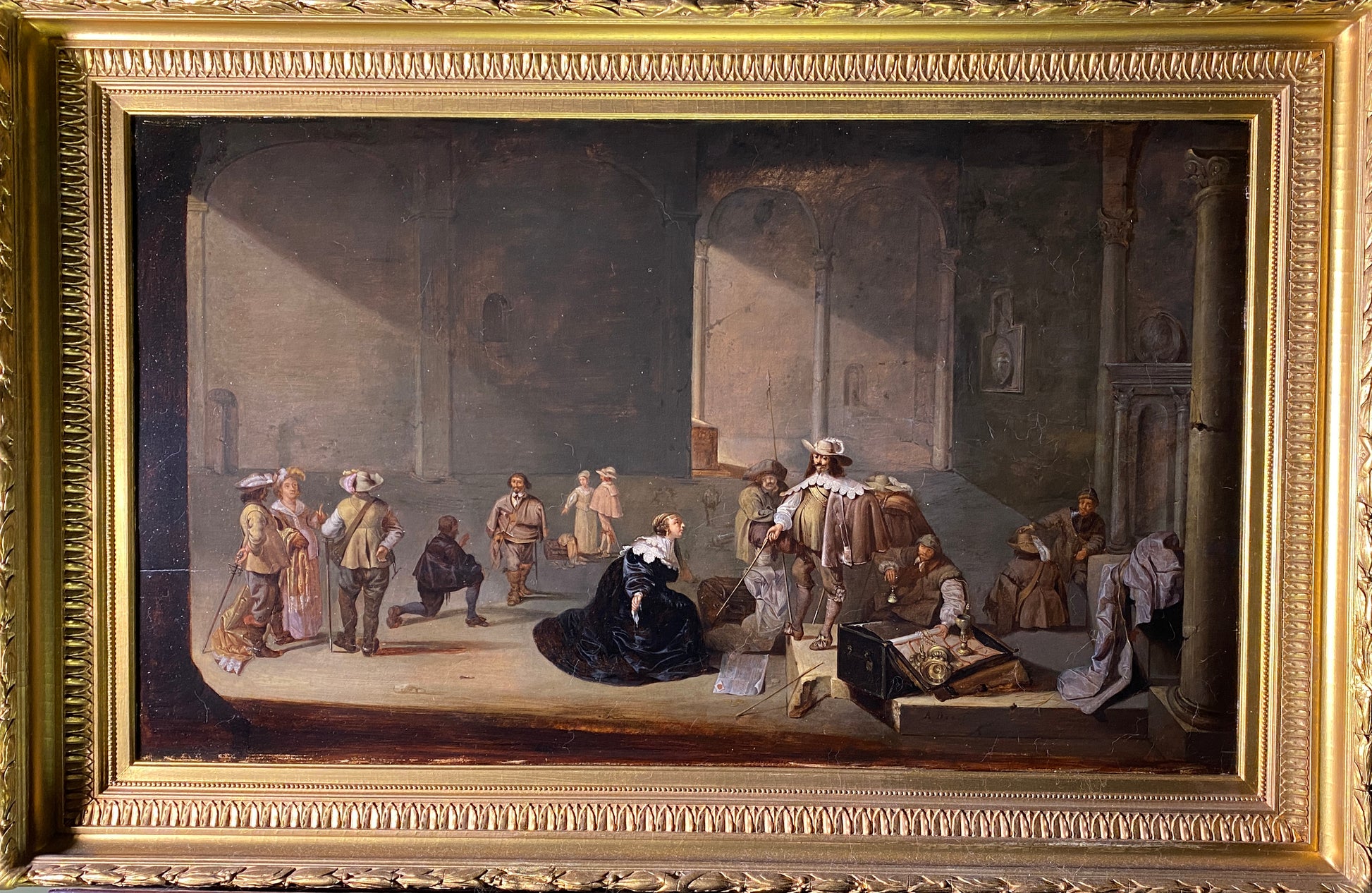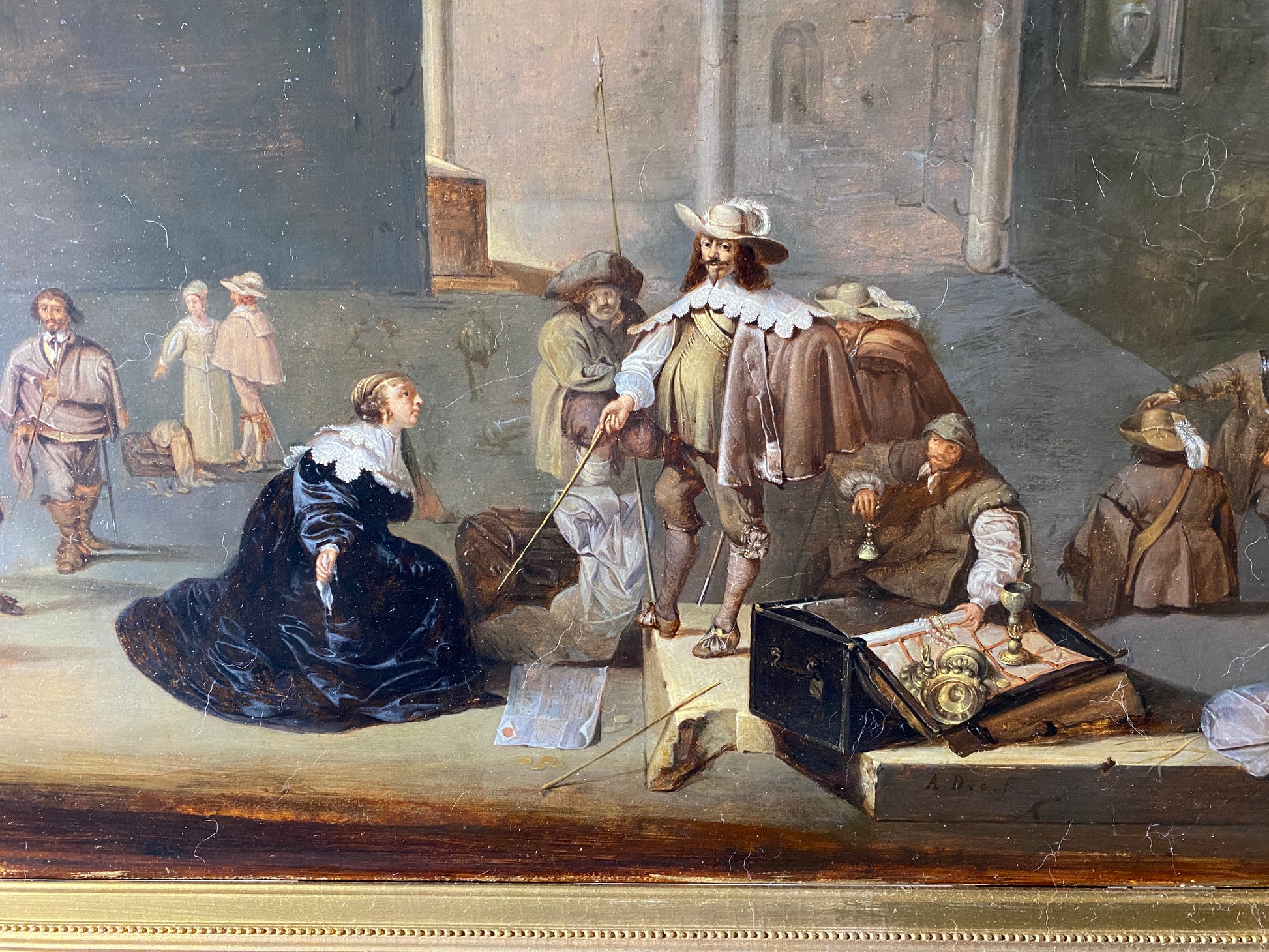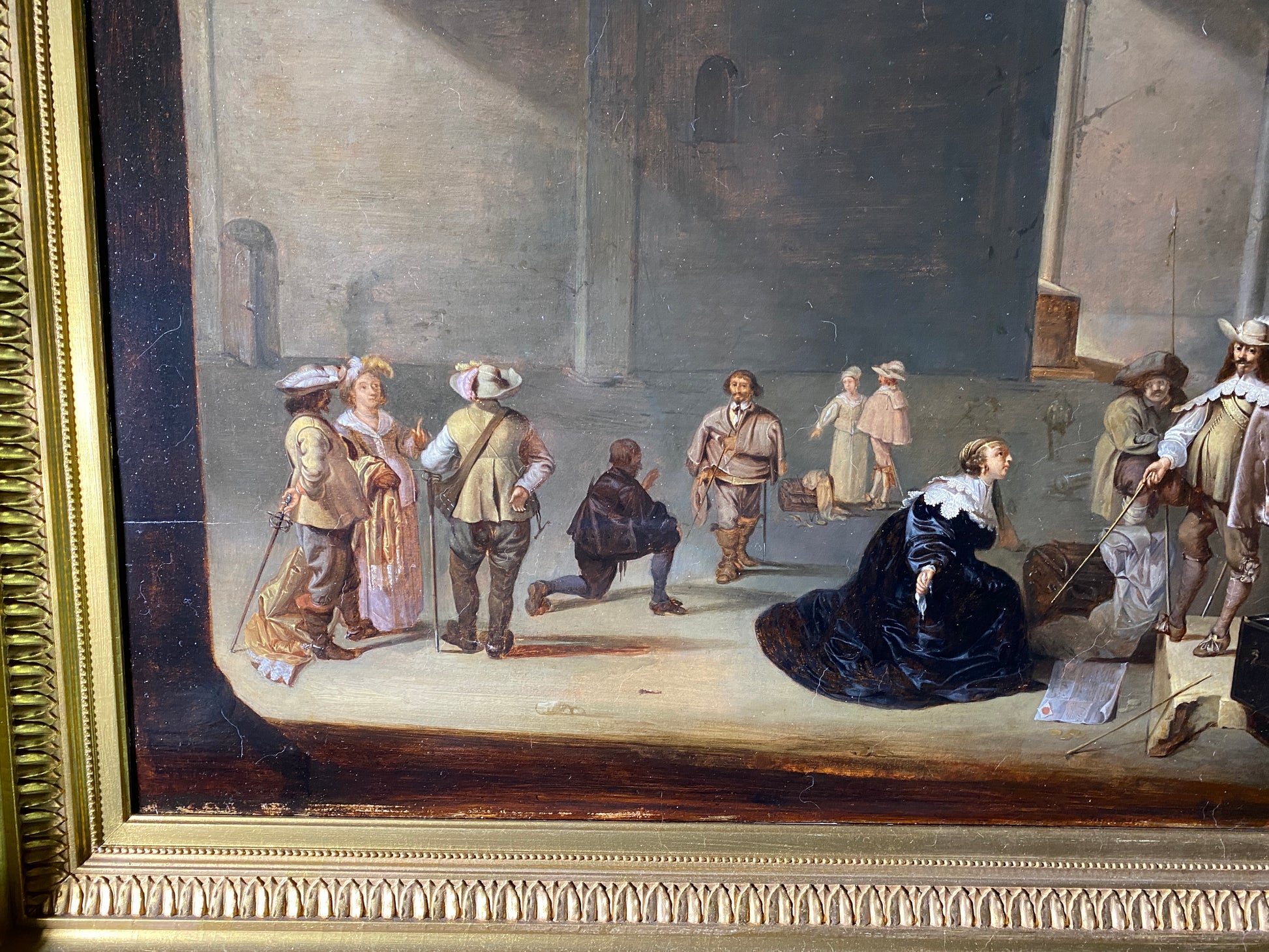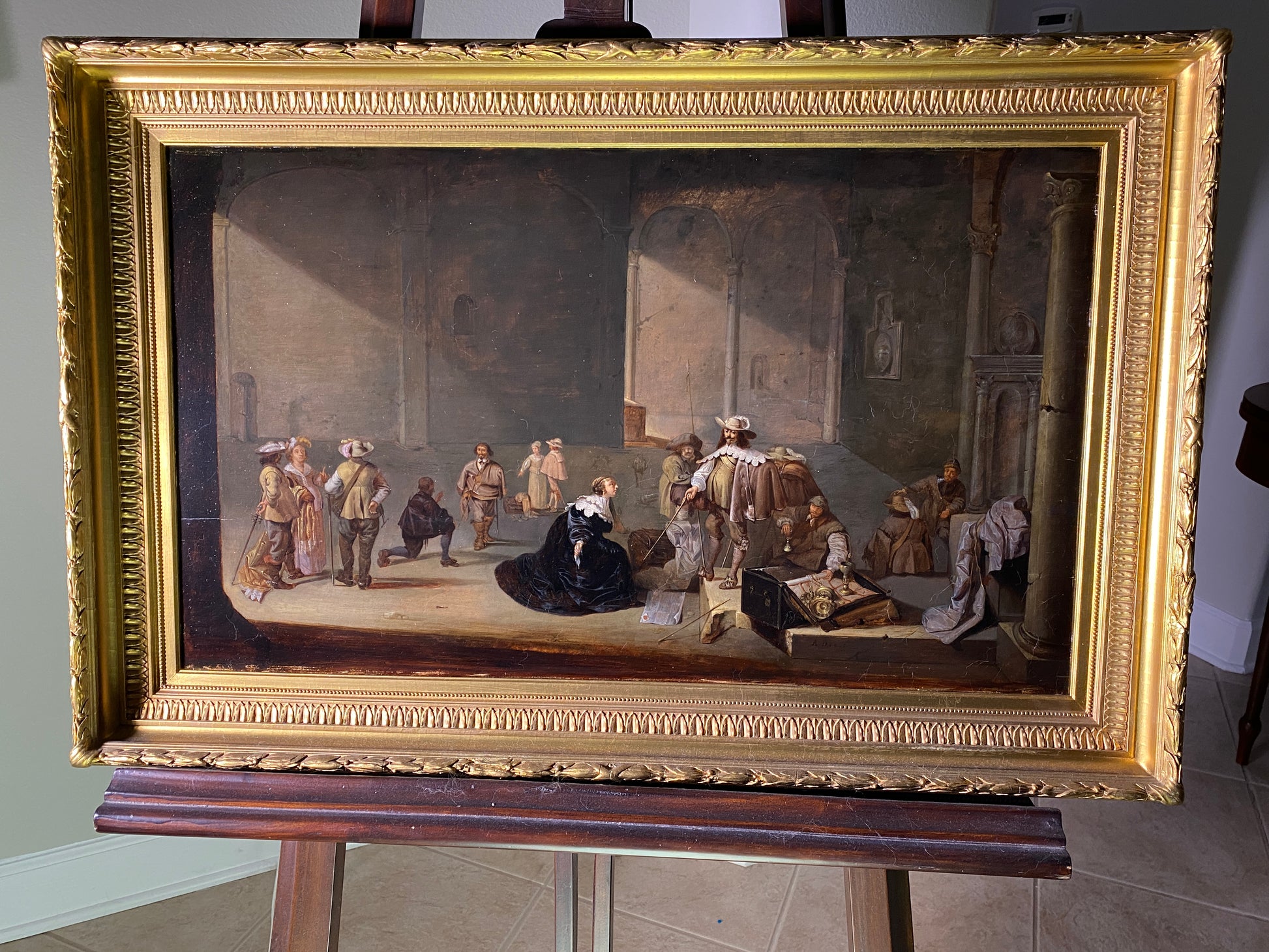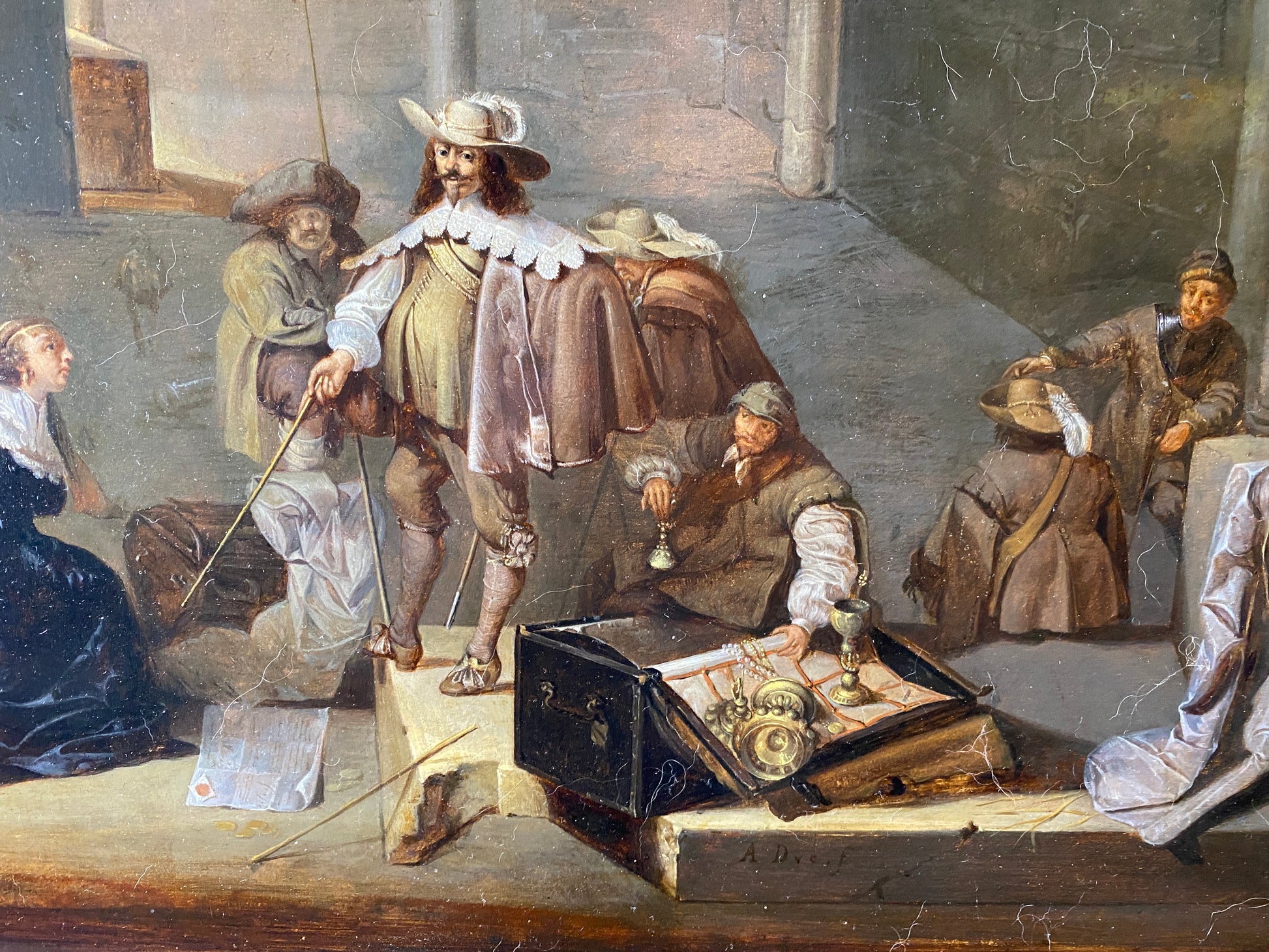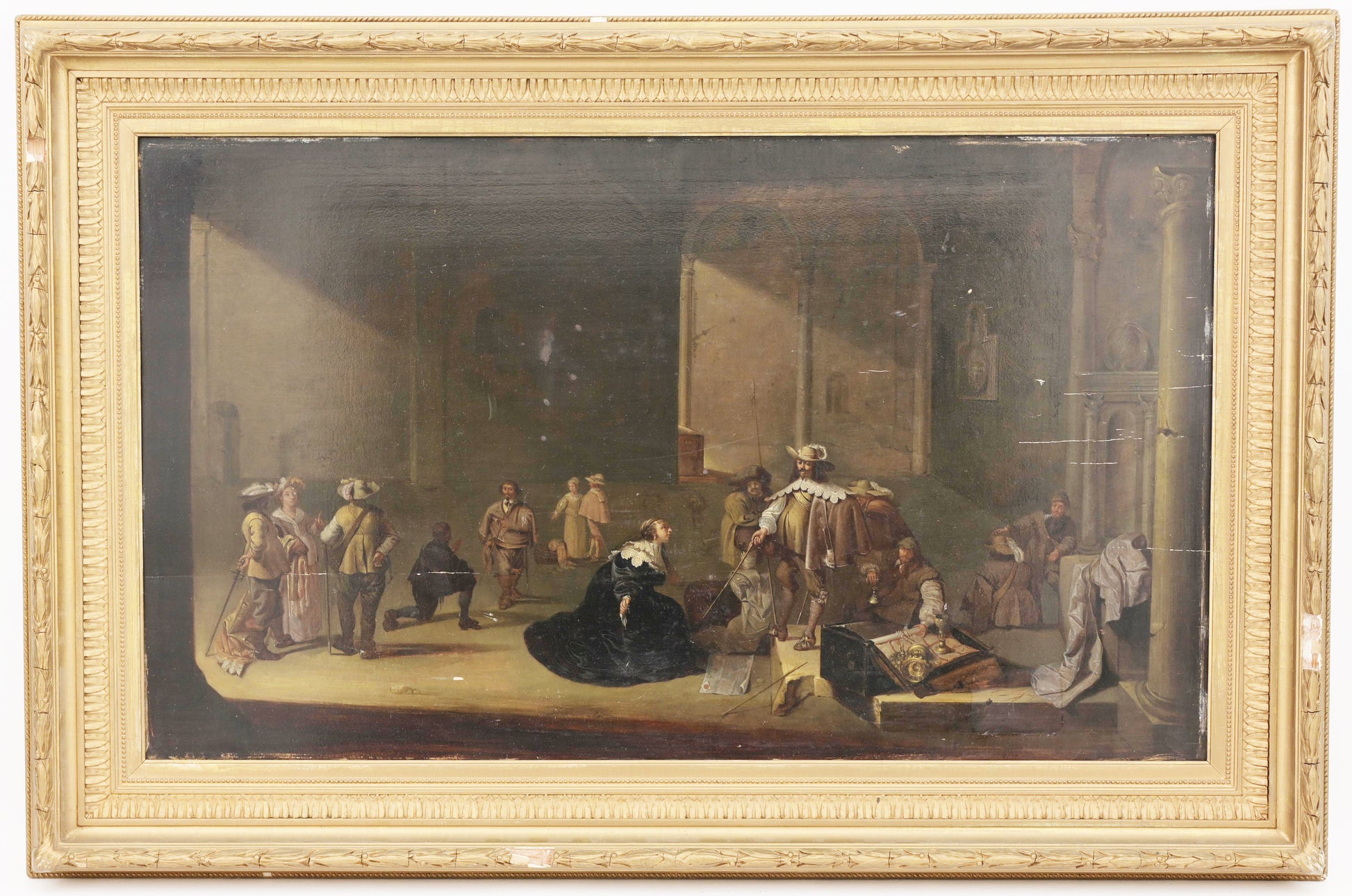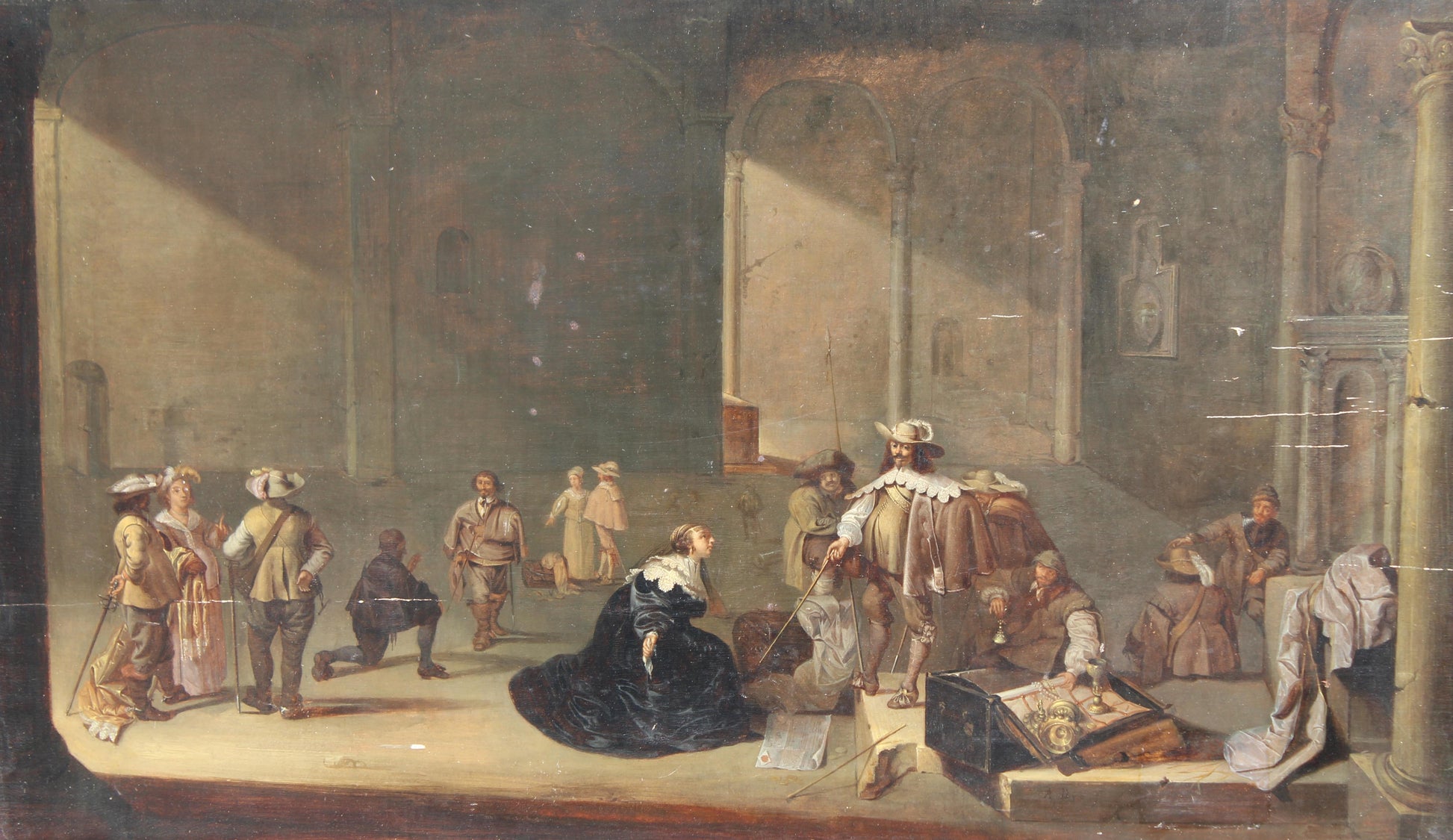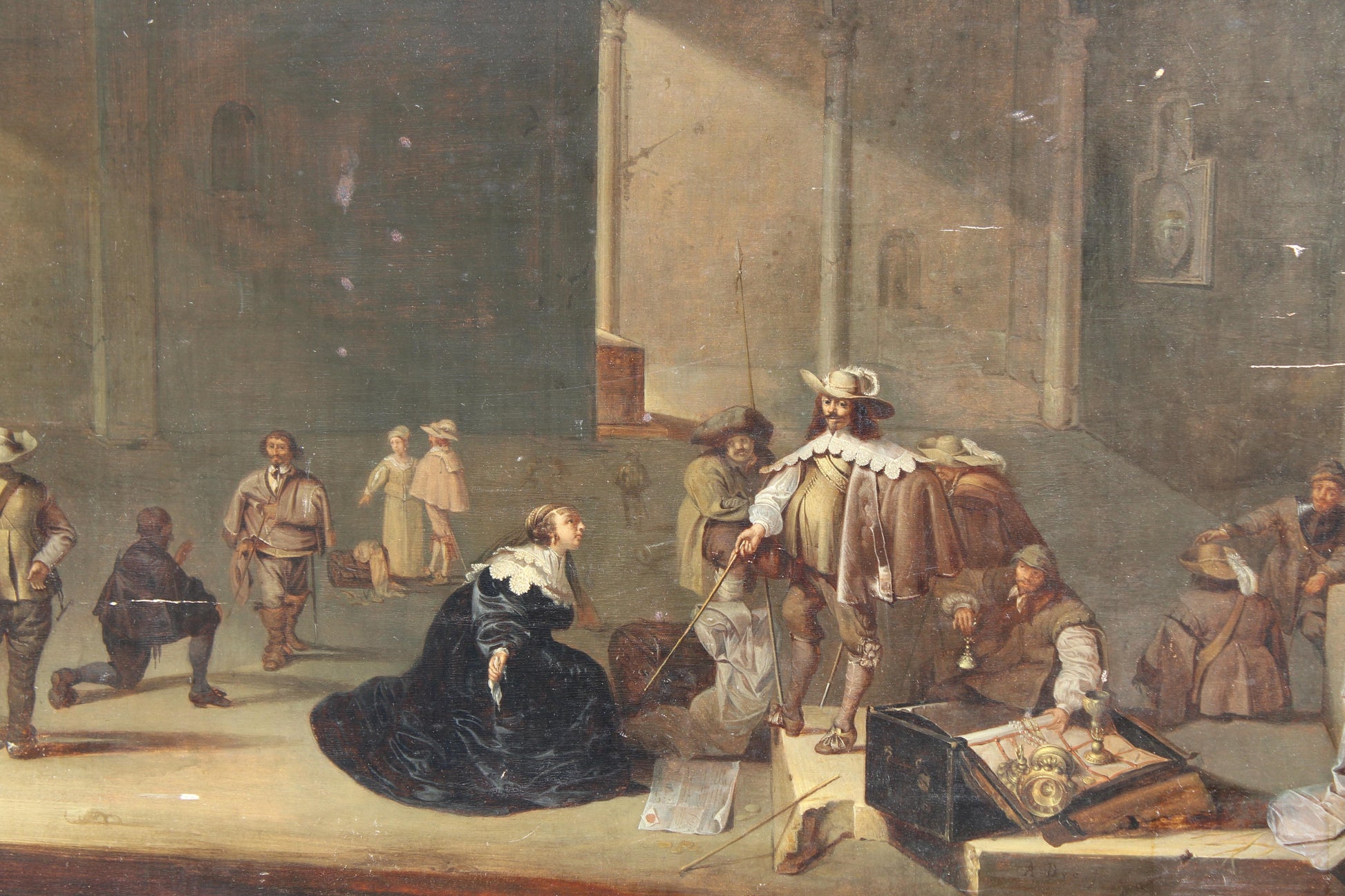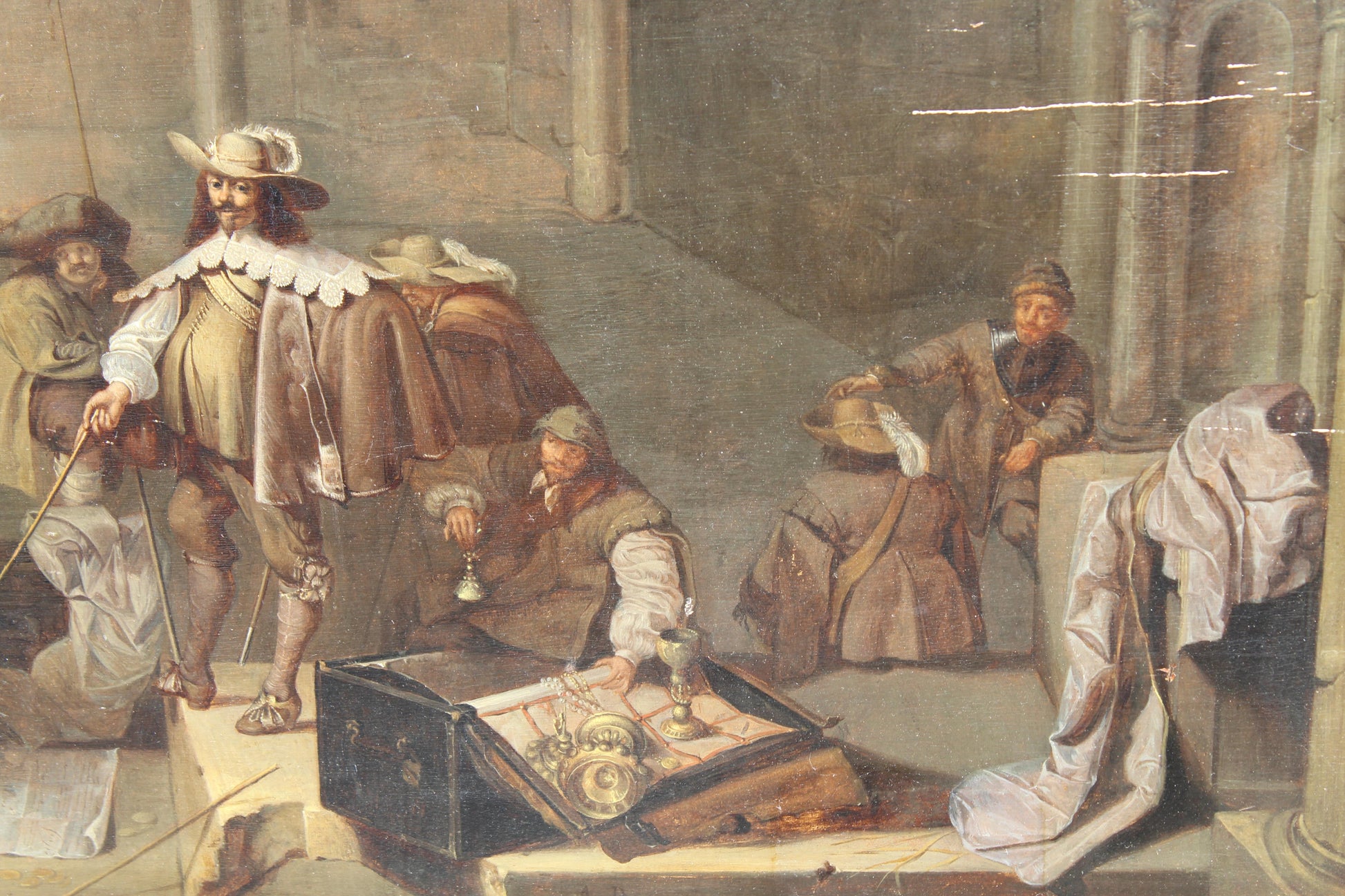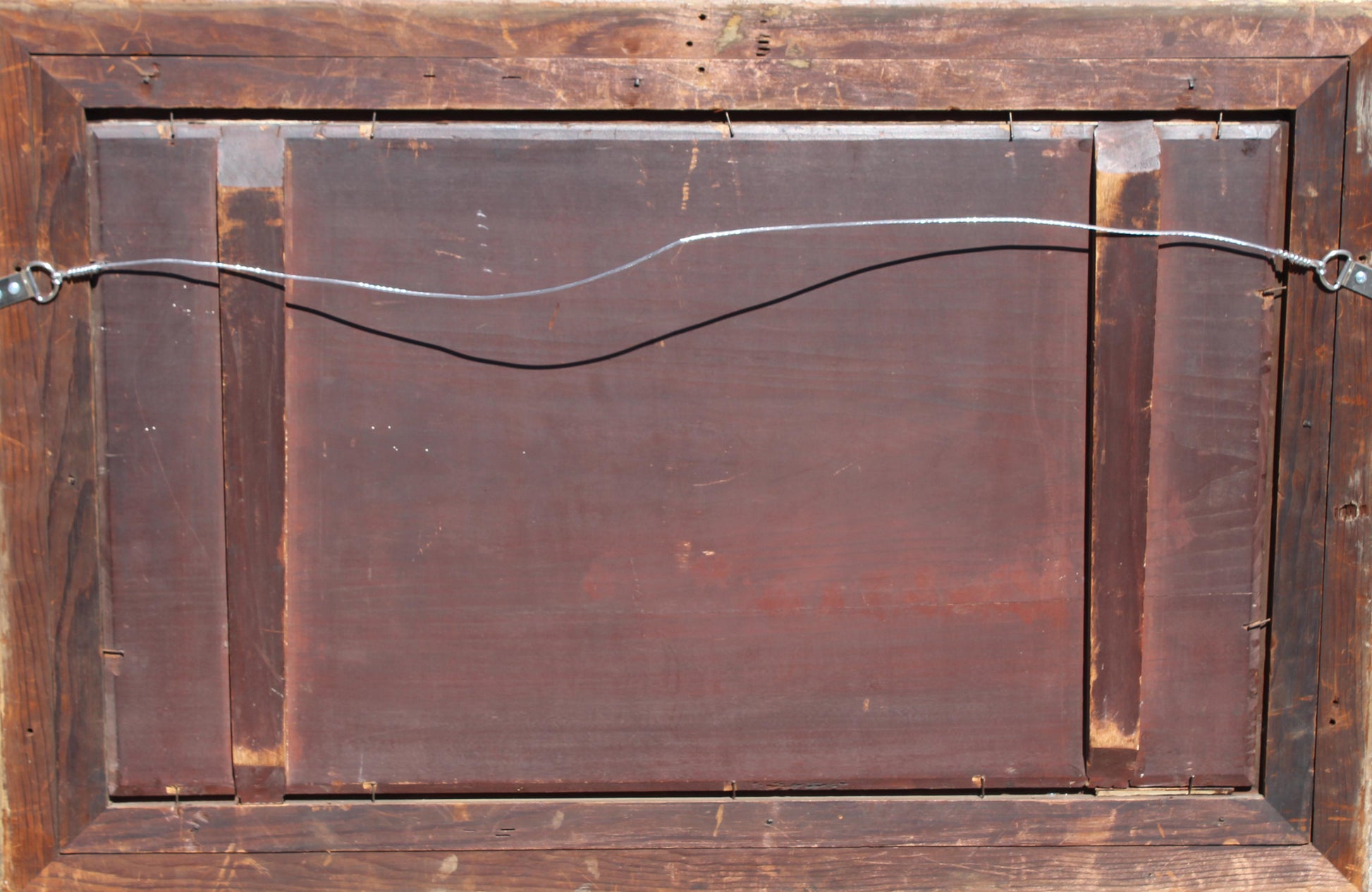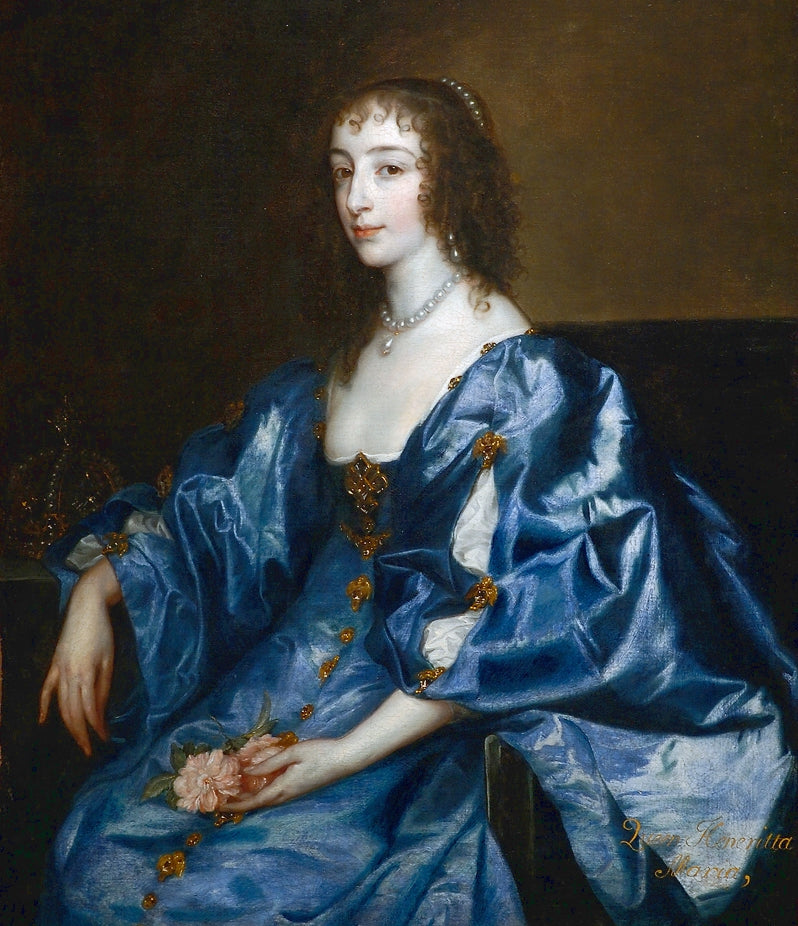Wondrous-Things.com (813) 409-4683
18th / 19th Century Henrietta Maria presenting herself with dowry to King Charles I of England Dutch Old Master
18th / 19th Century Henrietta Maria presenting herself with dowry to King Charles I of England Dutch Old Master
Couldn't load pickup availability
18th / 19th Century Henrietta Maria presenting herself with dowry to King Charles of England
RESTORED 2022
Dutch Old Master Style
Oil on panel with 19th Century gold gesso frame.
Very important subject matter: The dowry of Henrietta Maria daughter of King Henri IV of France was one of the largest dowries in history. The dowry stabilized the finances of King Charles I of England which was critical in fighting what was to become the English Civil War. Her blue dress is the same garment in her portrait painting done by Anthony Van Dyck. She is also wearing one of the most famous set of pearl earrings in history. (see Van Dyck painting final pic)
When Henry IV and Marie de' Medici's youngest daughter, princess Henriette Marie (1609-1699), married our Charles I in 1625, Marie gave the pendant pearl earrings to her as a wedding gift. Queen Henriette Marie was portrayed many times wearing the earrings, including in a portrait of her as a young wife, painted in 1632 by Sir Anthony van Dyck. But they brought the English queen no luck, as we know. The civil war forced Henriette Marie to flee the country in 1644. In exile, Queen Henrietta Marie was forced to gradually sell all her jewels, first to help support King Charles' army, and as a widow to keep herself from poverty. As mementos of happier times, the fabulous pearl earrings were among the last jewels to go, finally being purchased by her nephew, Louis XIV (1638-1714) in 1657.
Sight Size: 16.25 inches by x 28 inches
Overall Framed Size: 22.5 inches x 34.25 inches
$129.99 US flat rate shipping.
HENRIETTA MARIA, Queen of Charles I of England, born on the 25th of November 1609, was the daughter of Henry IV of France. When the first serious overtures for her hand were made on behalf of Charles, Prince of Wales, in the spring of 1624, she was little more than fourteen years of age. Her brother, Louis XIII, only consented to the marriage on the condition that the English Roman Catholics were relieved from the operation of the penal laws. When therefore she set out for her new home in June 1625, she had already pledged the husband to whom she had been married by proxy on the 1st of May to a course of action which was certain to bring unpopularity on him as well as upon herself.
That husband was now King of England. The early years of the married life of Charles I were most unhappy. He soon found an excuse for breaking his promise to relieve the English Catholics. His young wife was deeply offended by treatment which she naturally regarded as unhandsome. The favourite, Buckingham, stirred the flames of his master's discontent. Charles in vain strove to reduce her to tame submission.
After the assassination of Buckingham in 1628, the barrier between the married pair was broken down, and the bond of affection which from that moment united them was never loosened. The children of the marriage were Charles II (b. 1630), Mary, Princess of Orange (b. 1631), James II (b. 1633), Elizabeth (b. 1636), Henry, Duke of Gloucester (b. 1640), and Henrietta, Duchess of Orleans (b. 1644).
For some years Henrietta Maria's chief interests lay in her young family, and in the amusements of a gay and brilliant court. She loved to be present at dramatic entertainments, and her participation in the private rehearsals of the Shepherd's Pastoral, written by her favourite Walter Montague, probably drew down upon her the savage attack of Prynne. With political matters she hardly meddled as yet. Even her co-religionists found little aid from her till the summer of 1637. She had then recently opened a diplomatic communication with the see of Rome.
She appointed an agent to reside at Rome, and a papal agent, a Scotsman named George Conn, accredited to her, was soon engaged in effecting conversions amongst the English gentry and nobility. Henrietta Maria was well pleased to become a patroness of so holy a work, especially as she was not asked to take any personal trouble in the matter.
Protestant England took alarm at the proceedings of a Queen who associated herself so closely with the doings of "the grim wolf with privy paw." When the Scottish troubles broke out, she raised money from her fellow-Catholics to support the king's army on the borders in 1639. During the session of the Short Parliament in the spring of 1640, the queen urged the king to oppose himself to the House of Commons in defence of the Catholics. When the Long Parliament met, the Catholics were believed to be the authors and agents of every arbitrary scheme which was supposed to have entered into the plans of Strafford or Laud. Before the Long Parliament had sat for two months, the queen was urging upon the pope the duty of lending money to enable her to restore her husband's authority. She threw herself heart and soul into the schemes for rescuing Strafford and coercing the parliament. The army plot, the scheme for using Scotland against England, and the attempt upon the five members were the fruits of her political activity.
In the next year the queen effected her passage to the Continent. In February 1643 she landed at Burlington Quay, placed herself at the head of a force of loyalists, and marched through England to join the King near Oxford. After little more than a year's residence there, on the 3rd of April 1644, she left her husband, to see his face no more. Henrietta Maria found a refuge in France. Richelieu was dead, and Anne of Austria was compassionate. As long as her husband was alive the Queen never ceased to encourage him to resistance.
During her exile in France she had much to suffer. Her husband's execution in 1649 was a terrible blow. She brought up her youngest child Henrietta in her own faith, but her efforts to induce her youngest son, the Duke of Gloucester, to take the same course only produced discomfort in the exiled family. The story of her marriage with her attached servant Lord Jermyn needs more confirmation than it has yet received to be accepted, but all the information which has reached us of her relations with her children points to the estrangement which had grown up between them. When after the Restoration she returned to England, she found that she had no place in the new world. She received from parliament a grant of £30,000 a year in compensation for the loss of her dower-lands, and the King added a similar sum as a pension from himself. In January 1661 she returned to France to be present at the marriage of her daughter Henrietta to the Duke of Orleans. In July 1662 she set out again for England, and took up her residence once more at Somerset House. Her health failed her, and on the 24th of June 1665, she departed in search of the clearer air of her native country. She died on the 31st of August 1666, at Colombes, not far from Paris.
While Henrietta’s family sent her thousands of livres as a dowry, her husband, Charles I of England, did not care too much for the money. In fact, the couple could barely acknowledge each other without arguing.
Because Henrietta couldn’t stand her husband, she started spending time with her good friend, Lucy Hay. However, Henrietta started to give birth to children and soon began to feel differently toward her husband. In fact, by the time the future Charles II came into this world, the couple became inseparable.
Charles I and his wife, Henrietta Maria, fell in love after a rocky start and had children. Their youngest daughter, named Henrietta after her mother, married Philippe I, Duke of Orleans, in 1661. When the couple announced their marriage, Henrietta’s brother and mother started arranging the dowry because her father, Charles I, died years before.
Henrietta Maria (French: Henriette Marie; 25 November[1] 1609 – 10 September 1669) was Queen of England, Scotland, and Ireland from her marriage to King Charles I on 13 June 1625 until Charles was executed on 30 January 1649.
She was mother of his two immediate successors, Charles II and James II and VII. Contemporaneously, by a decree of her husband, she was known in England as Queen Mary, but she did not like this name and signed her letters "Henriette R" or "Henriette Marie R" (the "R" standing for regina, Latin for "queen".)
Henrietta Maria's Roman Catholicism made her unpopular in England, and also prohibited her from being crowned in a Church of England service; therefore, she never had a coronation. She immersed herself in national affairs as civil war loomed, and in 1644, following the birth of her youngest daughter, Henrietta, during the height of the First English Civil War, was compelled to seek refuge in France.
The execution of Charles I in 1649 left her impoverished. She settled in Paris and returned to England after the Restoration of Charles II to the throne. In 1665, she moved back to Paris, where she died four years later.
The North American Province of Maryland, a major haven for Roman Catholic settlers, was named in honour of Queen Henrietta Maria. The name was carried over into the current U.S. state of Maryland.
Materials
Materials
Shipping & Returns
Shipping & Returns
Dimensions
Dimensions
Care Instructions
Care Instructions
